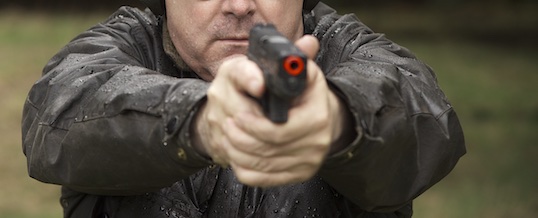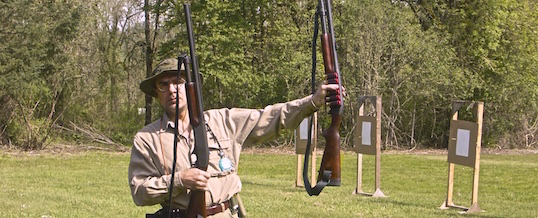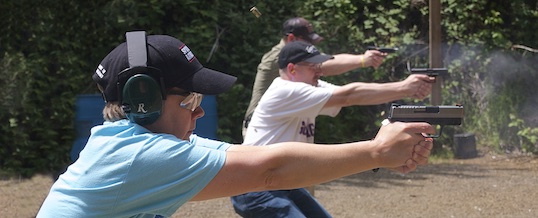
Airsoft for defensive shooting practice: good idea or a waste of time?
A question I’m frequently asked regards the value of non-firearm projectile launchers like Airsoft and BB guns as training devices for defensive shooting. This is a discussion that doesn’t lend itself to soundbites; there are some important principles which need to be understood to be able to gauge, for yourself, the value of any non-firearm alternatives.
When we talk about the physical skills of defensive shooting we’re talking about things like drawing the gun, getting it indexed on target, manipulating the controls on the gun to get it into a condition to fire, controlling deviation at the muzzle, pressing the trigger without inducing further deviation, and following through so that we can fire additional rounds if we recognize the need to do so. Are the non-firearms alternatives useful for practicing any of those skills?
To a certain extent they are, but the application may be more limited than you might think.
For instance, getting the gun out of the holster safely and efficiently is certainly a skill which you need to practice. Anything — even a completely non-functional dummy gun — will suffice for that use, as long as it is of a similar configuration to the gun you actually carry. Likewise getting the gun indexed on target, whether you’re using the sights or not, is easily and effectively done when using an Airsoft pistol. Manipulating the controls as part of your response, again as long as they’re similar to your real gun, can also be beneficially achieved with a non-firearm.
In fact, everything up to the breaking of the actual shot is easily and effectively trained with a firearm substitute. It’s when the shot is fired that the limitations of Airsoft and BB guns start to show themselves. Because they don’t act like real guns, and training of physical skills is affected by what you experience, you end up training yourself to expect something which doesn’t happen with a real gun. When you move to the real gun, that training you’ve done may not transfer. Allow me to illustrate with my experience.
My real-life example
It’s very easy to shoot an Airsoft gun. Too easy, in fact. The ones I have feature triggers so light that they’d be considered quite dangerous on a real firearm, which makes trigger manipulation much less demanding than on the real thing. The result is that trigger-finger-induced gun movement is dramatically reduced, which in turn means that I don’t need to focus on maintaining a proper grasp like I would with a real gun. Even if I force myself to do it, the forgiving nature of my Airsoft “Glock 19” isn’t like my real Glock 19 and over time I find myself slipping in my commitment to treat it like the real thing.
This issue continues when the “shot” breaks. Since the Airsoft doesn’t recoil anything like a real firearm it again doesn’t require the hard grasp that the actual gun does. Yes, it’s a training and commitment issue on the part of the shooter, but even after a few rounds I find myself relaxing my hands and arms because I simply don’t need the same level of control. I’ve experienced many times when I’ve practiced one day with the Airsoft, and the next went to the range with the real Glock 19 and almost had to re-learn proper grasp and exercise control over the gun. In fact, the first few rounds out of the real firearm invariably surprise me with their force and the resulting recoil! My accuracy is awful until I settle down and commit myself to exercising the fundamentals as applied to firearms, as opposed to being applied to the Airsoft.
The problem is worse with followup shots. Shooting multiple rounds out of the Airsoft is a non-event; since there is no recoil to speak of, and the gun really doesn’t move off target at all, the trigger can be manipulated much faster than when dealing with full-power recoil. If you’ve read any of my books or attended one of my classes, you already understand the concept of the tradeoff between time and precision. In those terms, the Airsoft has a radically different balance of speed and precision than a real gun.
The skills may not transfer to a real gun
Going to the range with an actual powder-burning autoloading pistol and trying to shoot at the same balance of speed and precision as I shoot the Airsoft is an exercise in frustration. I have to slow down dramatically to keep my rounds inside the designated target area, and the problem is made worse by the fact that the Airsoft reinforces a lack of physical control over those multiple rounds. The result is that large number of the rounds I fire in a real range session are spent re-learning basic concepts that the Airsoft allows me to ignore. Did I really gain anything from the expenditure of time and effort with the Airsoft if I need to re-learn it at the range?
My conclusion is that any manipulation or physical skill which is easier to perform with an Airsoft or BB gun has dubious training value. Whether it’s the trigger pull, the slide resistance, or the amount of recoil, unless you’re extremely cognizant and dedicated in your practice the non-firearm may in fact induce bad habits that you will need to spend time and effort correcting on the firing line. They aren’t real and so we don’t treat them like they’re real — and that reduces the training value we can get from them.
How to get value from training with an Airsoft gun
So, can you get value from using an Airsoft or BB gun as a training aid? I think so, which is why I still have mine. I’ve learned, however, to use them in a specific and controlled manner to gain real benefits and avoid the pitfalls.
I approach the Airsoft as a tool to help me practice the totality of a response as opposed to discrete physical skills. What I mean is that I don’t use it to practice the isolated physical skill of trigger control, for instance; instead, I use it as a confirmation or a marker that I’ve done everything else correctly and efficiently. For instance, as I react to a previsualized threat I might move off the vector of the attacker as I draw my gun, then come to a solid stop as the gun comes up out of the holster, extends onto the target, and the “shot” is fired. The BB hit on the target confirms that the hit was accurate or not, and if it wasn’t I can go back and analyze why. Was I still moving when I pressed the trigger? Were my arms at complete extension? If the target demanded a high level of precision was I using my sights correctly? The same approach can be used to practice movement around a structure, using cover, and so on.
All of those can be practiced and their application judged with the Airsoft or a BB gun, with the caveat that any given repetition must end at the first shot — repeated shots without actual recoil are of no benefit, and in fact may be detrimental to reinforcing the physical control necessary to maintain accuracy in a realistic string of fire.
There is much more to be said on the value of these non-firearms as training aids, particularly with their use in training the shooting-while-in-contact part of self defense, but I hope this gives you some idea of their benefits and limitations in practicing your realistic defensive shooting skills.
– Grant Cunningham
- Posted by Grant Cunningham
- On March 1, 2016



